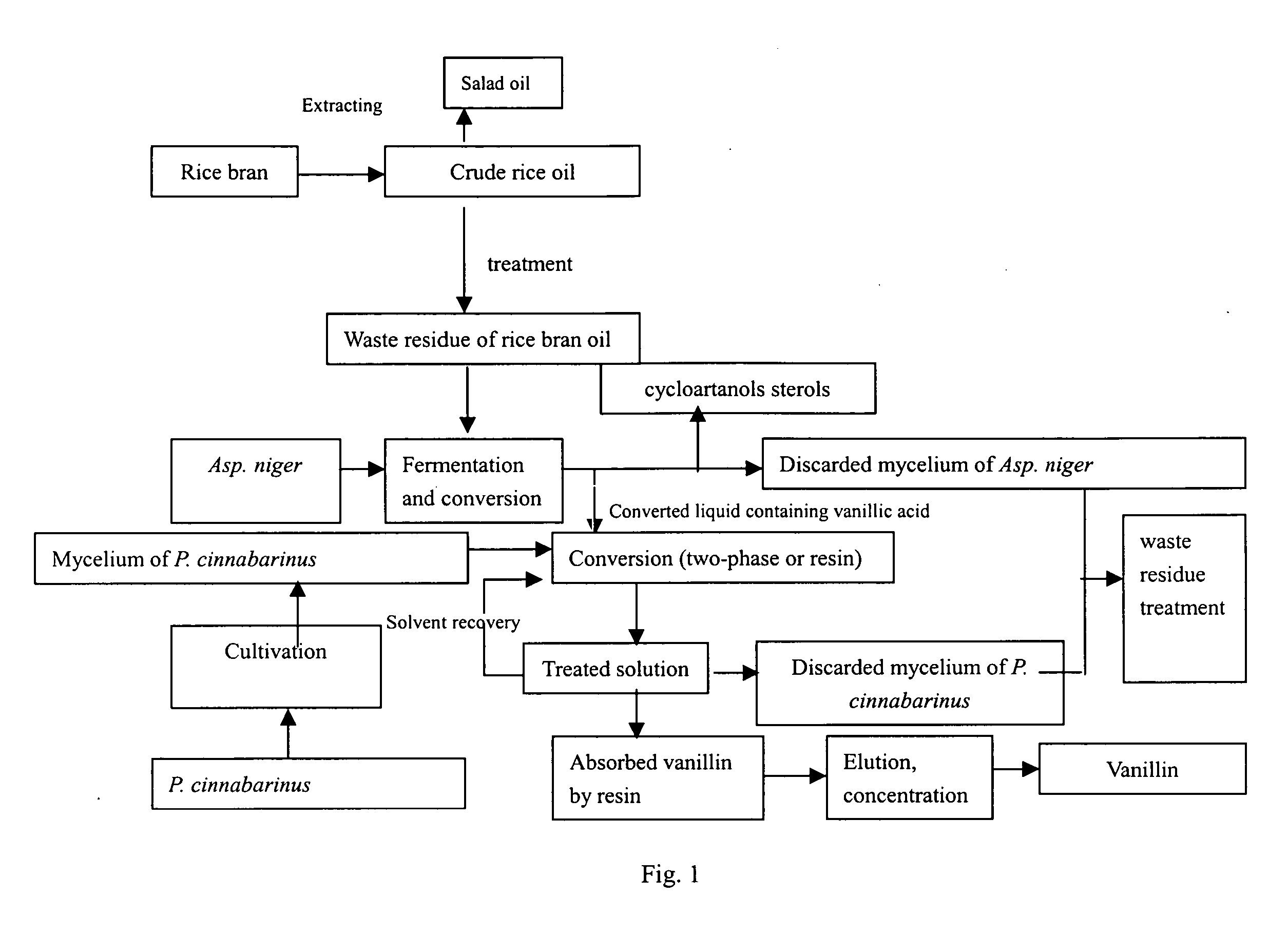Method for the producing vanillic acid and vanillin from waste residue of rice bran oil by fermentation and biotransformation
a technology of rice bran oil and vanillin, which is applied in the field of biotransformation and production of vanillic acid and vanillin, can solve the problems of high price (1,200-4,000 $/kg), toxic starting materials used in these methods such as guaiacol, and environmental pollution, and achieves the elimination of the toxic effect of vanillin, the effect of reducing the production cost of vanillin and being safe for food production
- Summary
- Abstract
- Description
- Claims
- Application Information
AI Technical Summary
Benefits of technology
Problems solved by technology
Method used
Image
Examples
example
Example 1
[0047] A mycelial mass was scraped from a grown fresh slant of Asp. niger CGMCC 0774 and added to 100 mL of sterilized water. Glass beads were added to the water and beating was continued at 180 rpm for 20 minutes. The concentration of spore solution obtained was about 106 / mL. The spore solution was inoculated into 800 mL of seed culture medium in an amount of 10% and incubated at 30° C., 170 rpm for 2 days. The seed culture was shattered for 20 minutes and the solution obtained was added to a fermentation medium, which had been autoclaved at 120° C. for 20-50 minutes and cooled. The fermentation medium contained 20 g / L of maltose, 10 g / L of diammonium tartrate, 2 g / L of yeast extract, 1 g / L of potassium dihydrogen phosphate, 5 g / L of calcium chloride and 0.5 g / L of magnesium sulfate, pH 7.0. The fermentation conditions were as follows: 100 ml culture medium / 250 ml flask, seed volume: 10%, 35° C., 120 rpm. After culture for 40 hours, a solution of niger of rice bran oil wa...
example 2
[0048]Asp. niger CGMCC 0774 was cultivated according to Example 1. The seed culture was placed in an inoculation bottle, inoculated into a 15 L fermentor filled with 8 L sterilized fermentation broth and cultured for 44 hours under fermentor conditions at 37° C., 200 rpm, with an aeration of 1 vvm and 0.1 Mpa of tank pressure. 1 L of 10 g / L sterilized ferulic acid solution (sodium salt solution, pH 7.0) obtained in Example 1 was added and conversion reaction was performed under the same conditions for 34 hours. Sampled at constant time interval and detected by Thin-Layer Chromatography (TLC). Upon the ferulic acid was nearly exhausted, the concentration of vanillic acid was detected to be 0.506 g / L, corresponding to a molar conversion yield of 83.32%. The biomass (thallus dry weight) could reach up to 4.8 g / L.
example 3
[0049]Asp. niger CGMCC 0774 was cultivated according to Example 1. The strain was inoculated into 1.6 L of seed culture medium in an amount of 10% and cultured at 30° C., 170 rpm for 2 days. The seed culture was placed in an inoculation bottle, inoculated into a 25 L fermentor filled with 16 L sterilized fermentation broth and cultured for 41 hours under fermentor conditions at 37° C., 200 rpm, with an aeration of 1 vvm and 0.1 Mpa of tank pressure. When pH decreased to a value below pH 3.1, 1 L of 36 g / L sterilized ferulic acid solution (sodium salt solution, pH 7.0) obtained by concentration or crystallization in Example 1 was added and conversion reaction was performed under the same fermentor conditions for 36 hours, wherein the concentration of ferulic acid in converted liquid was detected to be 2.0 g / L. Thereafter, 33 g ferulic acid was formulated into IL sterilized solution of ferulic acid sodium salt (pH 7.0) and fed to the culture medium. The concentration of ferulic acid i...
PUM
| Property | Measurement | Unit |
|---|---|---|
| concentration | aaaaa | aaaaa |
| concentration | aaaaa | aaaaa |
| concentration | aaaaa | aaaaa |
Abstract
Description
Claims
Application Information
 Login to View More
Login to View More - R&D
- Intellectual Property
- Life Sciences
- Materials
- Tech Scout
- Unparalleled Data Quality
- Higher Quality Content
- 60% Fewer Hallucinations
Browse by: Latest US Patents, China's latest patents, Technical Efficacy Thesaurus, Application Domain, Technology Topic, Popular Technical Reports.
© 2025 PatSnap. All rights reserved.Legal|Privacy policy|Modern Slavery Act Transparency Statement|Sitemap|About US| Contact US: help@patsnap.com


